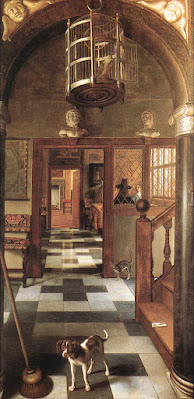My British cousin, Karen Demuth, introduced us to the work of Patrick Hughes (1939- ) years ago when she worked at the Flowers Gallery in London. If we had been collectors of contemporary art, we would have bought one of his paintings and, though I am very much against collecting as an investment, this would have been a good candidate. In 2014 the gallery produced a 240-page monograph on Hughes “A Newer Perspective”. When I see one of his paintings, even in reproduction, I still feel that I am not just an onlooker but a participant, walking down the alleyways of his vision. But I am getting ahead of myself.
Time has passed and Karen has left Flowers and is now Hughes’ agent, managing his sales and exhibition program in coordingation with museums and galleries.
I am writing about him now because he will have an exhibition from April 1 to May 30 in the venerable New Orleans gallery, M.S. Rau, founded in 1912. They are calling it, “The Witty World of Patrick Hughes”. If you are not able to be in New Orleans the show will be available at msrau.com.
Hughes has works in a number of public collections including the Tate Gallery, the Victoria and Albert Museum, The Birmingham Museum and Art Gallery, the Guggenheim Museum, New York, The Denver Art Museum, the Museum of Fine Arts, Boston. His work has also been seen in exhibitions around the world.
Here is an image of a painting belonging to the Birmingham Museum ...
 |
| Credit: Birmingham Museums Trust |
What makes Patrick Hughes distinctive is the optical technique by which he envelops you in the scene he depicts. Inspired by his childhood experience staring up at the underside of the basement stairs as he hid from the World War II bombing raids, he developed what he calls “Reverspectives”. These are “three-dimensional works painted on projecting panels that give different readings of a scene as the viewer moves.
Hughes has been credited with “inventing” reverse perspective. With reverse perspective objects farther away from the viewing plane are drawn as larger, and closer objects are drawn as smaller, in contrast to the more conventional linear perspective for which closer objects appear larger.
I find the painting titled “Catalogues 2021” most enticing. It evokes the experience of actually being part of the library as opposed to wandering down its rows of shelves.
The full effect is impossible to see in a photograph, but you can get the idea from the video of a Hughes’ painting where you seem to move through the Barnes Collection.
Linear perspective is certainly not new. Brendan Flynn, curator of Fine Art, Birmingham (England) Museum & Art Gallery writes, “Hughes is developing a line of enquiry which has preoccupied generations of European artists. The architect Brunelleschi (1377-1446) was one of the first artists to make interactive artwork that demonstrated the principle of perspective. By example here is a painting by Samuel van Hoogstraten (1627-1678) View of a Corridor (1662).
 |
| Dyrham Park, National Trust |
The Flynn article continues, “His discovery and development of reverse perspective gave Hughes an even more potent mechanism for loosening the grip of experience on the viewer’s imagination. It relies on the fact that the human brain and eye are adapted during early childhood to apprehend space in terms of linear perspective – converging parallel lines imply recession and distant objects appear smaller.”
Viewing a Hughes painting is a truly interactive experience that can be disorienting at first as the artist makes you forget what you know of your own world as he allows you to get lost in his.






No comments:
Post a Comment